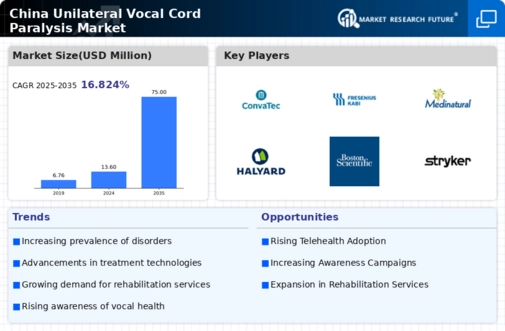Rising Geriatric Population
The aging population in China is a significant factor influencing the unilateral vocal-cord-paralysis market. As individuals age, the likelihood of developing vocal cord issues increases, leading to a higher incidence of unilateral vocal cord paralysis among the elderly. This demographic shift is prompting healthcare providers to focus on age-related vocal health, thereby driving demand for specialized treatments. The unilateral vocal-cord-paralysis market is expected to grow as healthcare systems adapt to the needs of this population, offering tailored solutions that address the unique challenges faced by older patients.
Advancements in Surgical Techniques
Innovations in surgical techniques for treating unilateral vocal cord paralysis are significantly influencing the market landscape. Minimally invasive procedures, such as endoscopic techniques, have gained traction, offering patients reduced recovery times and improved outcomes. The unilateral vocal-cord-paralysis market is witnessing a shift towards these advanced methodologies, which are often associated with lower complication rates. Furthermore, the integration of robotic-assisted surgeries is enhancing precision and efficacy, attracting more patients to seek surgical interventions. As these techniques become more widely adopted, the market is likely to experience substantial growth, driven by the demand for safer and more effective treatment options.
Rising Incidence of Vocal Cord Disorders
The increasing prevalence of vocal cord disorders in China is a primary driver for the unilateral vocal-cord-paralysis market. Recent studies indicate that approximately 3-5% of the population may experience some form of vocal cord dysfunction, leading to a heightened demand for effective treatment options. This trend is particularly pronounced in urban areas, where environmental factors and lifestyle choices contribute to vocal health issues. As awareness of these disorders grows, healthcare providers are more likely to seek innovative solutions, thereby expanding the market. The unilateral vocal-cord-paralysis market is poised to benefit from this rising incidence, as patients seek specialized care and advanced therapeutic interventions.
Growing Demand for Non-Surgical Treatment Options
The unilateral vocal-cord-paralysis market is experiencing a shift towards non-surgical treatment options, driven by patient preferences for less invasive therapies. Voice therapy, corticosteroid injections, and other conservative management strategies are gaining popularity as effective alternatives to surgery. This trend is particularly relevant in China, where patients often seek to avoid the risks associated with surgical procedures. The market is adapting to this demand by developing and promoting non-invasive therapies, which are perceived as safer and more convenient. As awareness of these options increases, the market is likely to expand, catering to a broader range of patient needs.
Increased Investment in Healthcare Infrastructure
China's ongoing investment in healthcare infrastructure is a crucial driver for the unilateral vocal-cord-paralysis market. The government has committed to enhancing healthcare facilities and services, particularly in underserved regions. This expansion includes the establishment of specialized clinics and hospitals equipped to handle vocal cord disorders. As healthcare access improves, more patients are likely to seek diagnosis and treatment for unilateral vocal cord paralysis. The unilateral vocal-cord-paralysis market stands to gain from this trend, as increased accessibility leads to higher patient volumes and a greater need for therapeutic solutions.



















Leave a Comment